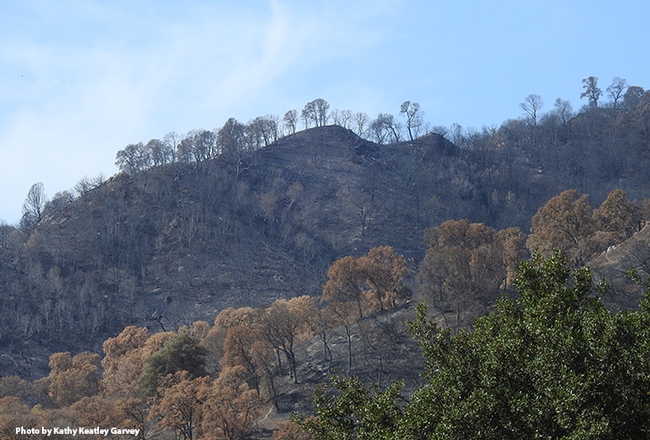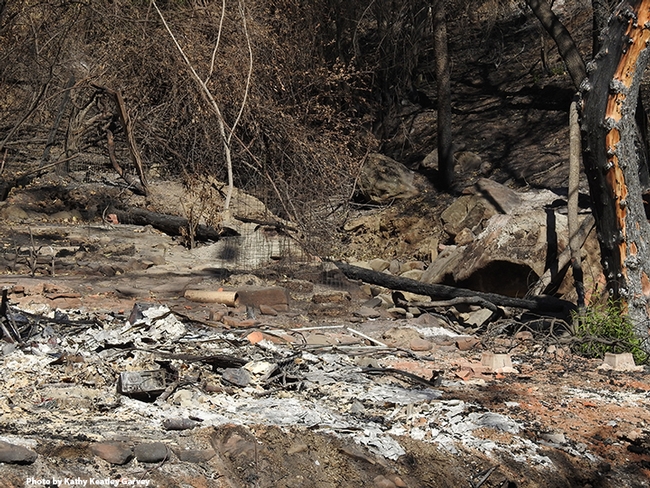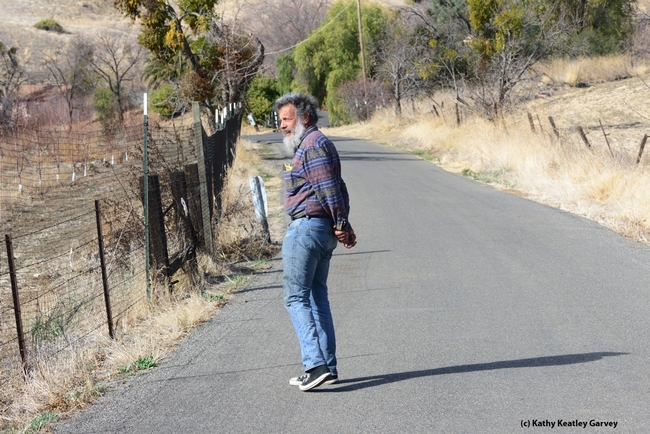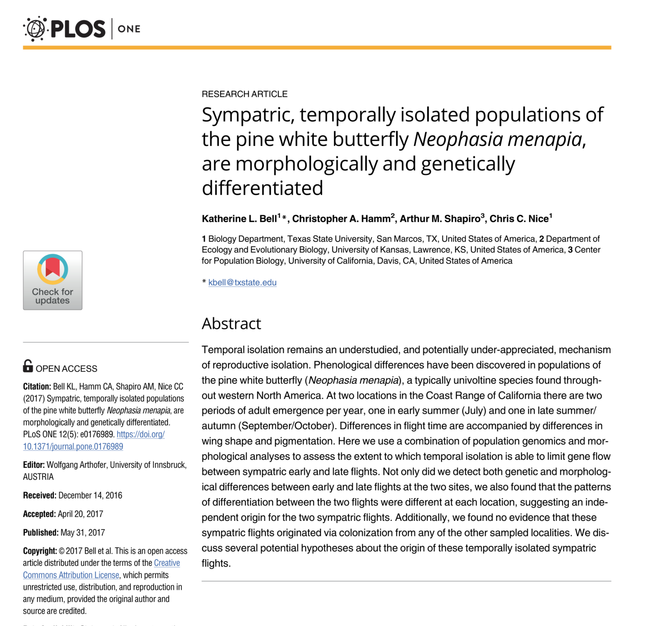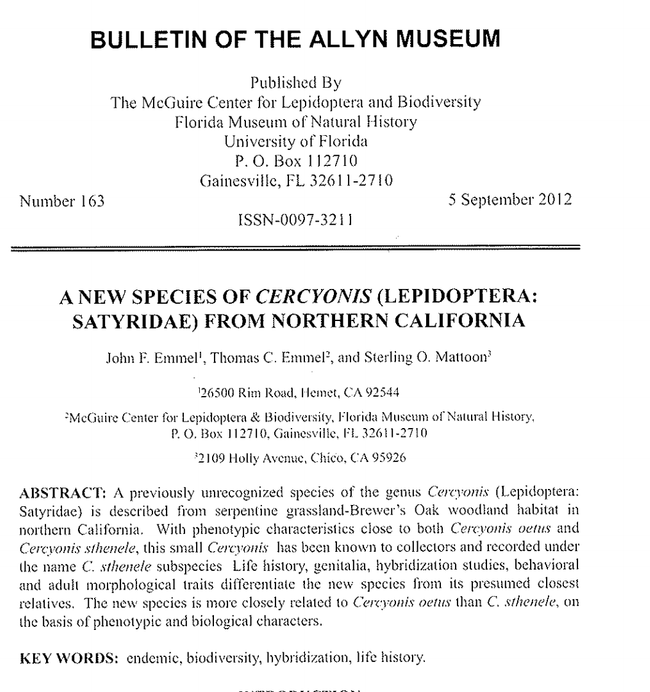- Author: Kathy Keatley Garvey
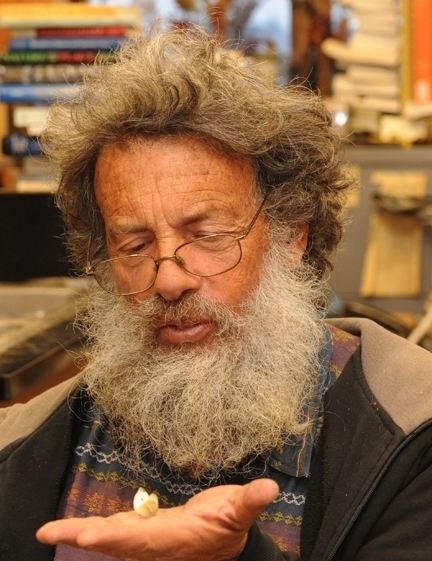
“It's of special interest this year because as of a few days ago the bug was still flying and laying eggs, which will result in non-diapause pupae,” said Shapiro, a noted butterfly expert who researches biological responses to climate change. “Depending on the weather, that could mean an earlier-than-usual emergence. There is even a slight chance the fall brood is not over yet...”
Shapiro, a member of the Department of Evolution and Ecology faculty, has sponsored the “Suds for a Bug” contest since 1972 to determine the Pieris rapae's first flight of the year in the three-county area of Sacramento, Solano and Yolo. He launched the contest as part of his long-term studies of butterfly life cycles and climate change.
P. rapae is emerging earlier and earlier as the regional climate has warmed, said Shapiro. "Since 1972, the first flight of the cabbage white butterfly has varied from Jan. 1 to Feb. 22, averaging about Jan. 20."
Shapiro, who has monitored butterfly populations of central California since 1972 and maintains a research website at http://butterfly.ucdavis.edu/, says the point of the contest "is to get the earliest possible flight date for statistical purposes. The rules require that the animal be captured and brought in alive to be verified. That way no one can falsely claim to have seen one or misidentify something else as a cabbage white."
The contest rules include:
- It must be an adult (no caterpillars or pupae) and be captured outdoors.
- It must be brought in alive to the Department of Evolution and Ecology office, 2320 Storer Hall, UC Davis, during work hours, 8 a.m. to 5 p.m., Monday through Friday, with the full data (exact time, date and location of the capture) and the contact information of the collector (address, phone number and/or e-mail.) The receptionist will certify that it is alive and refrigerate it. (If it's collected on a weekend or holiday, it can be kept in the refrigerator for a few days--do not freeze it.)
- Shapiro is the sole judge.
The professor said P. rapae inhabits vacant lots, fields and gardens where its host plants, weedy mustards, grow. The male is white. The female is often slightly buffy; the "underside of the hindwing and apex of the forewing may be distinctly yellow and normally have a gray cast,” Shapiro said. “The black dots and apical spot on the upperside tend to be faint or even to disappear really early in the season.”
Shapiro, who monitors butterfly populations in the field for more than 200 days of the year, usually wins the contest. He has been defeated only four times and those were by UC Davis graduate students. Adam Porter won in 1983; Sherri Graves and Rick VanBuskirk each won in the late 1990s; and Jacob Montgomery in 2016. The first three were his own graduate students.
A fellow of the American Association for the Advancement of Science, the Royal Entomological Society and the California Academy of Sciences, Shapiro is the author of A Field Guide to Butterflies of the San Francisco Bay and Sacramento Valley Regions, illustrated by Tim Manolis and published in 2007 by the University of California Press
Recent Beer-for-a-Butterfly Contest statistics:
- 2022: No official contest due to the COVID pandemic, but Shapiro recorded his first-of-the-year P. rapae at 1:25 p.m. on Jan. 19 in West Sacramento, Yolo County
- 2021: No official contest due to the COVID pandemic, but Shapiro collected his first-of-the-year at 1:55 p.m. Jan. 16 on the UC Davis campus, Yolo County
- 2020: Technically, no winner, as Shapiro did not collect the one he spotted in Winters, Yolo County at 11:16 a.m. on Jan. 30 at the Putah Creek Nature Park. "It flew back and forth across Putah Creek and then departed the area, flying out of reach above the trees," he noted. He waited around for 90 minutes to see if it would return. It did not.
- 2019: Shapiro collected the first cabbage white butterfly near the Suisun Yacht Club, Suisun City, Solano County, at 1:12 p.m., Friday, Jan. 25. "It was the earliest recorded in Suisun City in 47 seasons."
- 2018: Art Shapiro collected the winner in West Sacramento
- 2017: Jan. 19: Art Shapiro collected the winner on the UC Davis campus
- 2016: Jan. 16: Jacob Montgomery collected the winner in west Davis
- 2015: Jan. 26: Shapiro collected the winner in West Sacramento
- 2014: Jan. 14: Shapiro collected the winner in West Sacramento
- 2013: Jan. 21: Shapiro collected the winner in West Sacramento
- 2012: Jan. 8: Shapiro collected the winner in West Sacramento
- 2011: Jan. 31: Shapiro collected the winner in Suisun
- 2010: Jan. 27: Shapiro collected the winner in West Sacramento
Shapiro nets many of the winners in mustard patches near railroad tracks in West Sacramento, Yolo County.
As a caterpillar, the insect is a pest of cole crops such as cabbage. UC Statewide Integrated Pest Management Program (UC IPM) says the cabbageworm is active throughout the year in California. "Cabbageworm larvae chew large, irregular holes in leaves, bore into heads, and drop greenish brown fecal pellets that may contaminate the marketed product. Seedlings may be damaged, but most losses are due to damage to marketed parts of the plant," according to the UC IPM website.
Related Link:
Research Publication on Non-Diapause Overwintering Cabbage White Butterfly and Anise Swallowtail
Non-Diapause Overwintering by Pieris rapae (Lepidoptera: Pieridae) and Papilio zelicaon (Lepidoptera: Papilionidae) in California: Adaptiveness of Type III Diapause-Induction Curves by Art Shapiro, published in 1984 in Psyche: A Journal of Entomology (open access article)
First paragraph: "Diapause is generally regarded as a physiological adaptation which increases the probability of surviving the adverse season, and thus of reproducing after it is over. Many insect species show geographic differences in the environmental regimes which induce or inhibit diapause (e.g., critical photoperiod) and in the strength of the diapause induced. Such interpopulational differences are commonly viewed as "fine tuning" to local climates, accomplished by natural selection and reflecting a genetic basis (e.g., Istock, 1981). Intrapopulational differences in photoperiodic sensitivity and diapause strength (e.g., chilling requirement) also occur, and have been interpreted as polymorphisms which "spread the risk" of environmental uncertainty over the population (cf. Bradshaw 1973, Shapiro 1979, 1980a). In multivoltine insects in seasonal climates, offspring produced by the last seasonal generation of adults are commonly induced to enter diapause by specific combinations of environmental factors; in mid-latitudes these are likely to be decreasing photophase/increasing scotophase and decreasing or consistently low night temperatures. Warmer nights tend to shorten the critical photoperiod for a given population, or may effectively inhibit diapause altogether under field conditions." (See more)
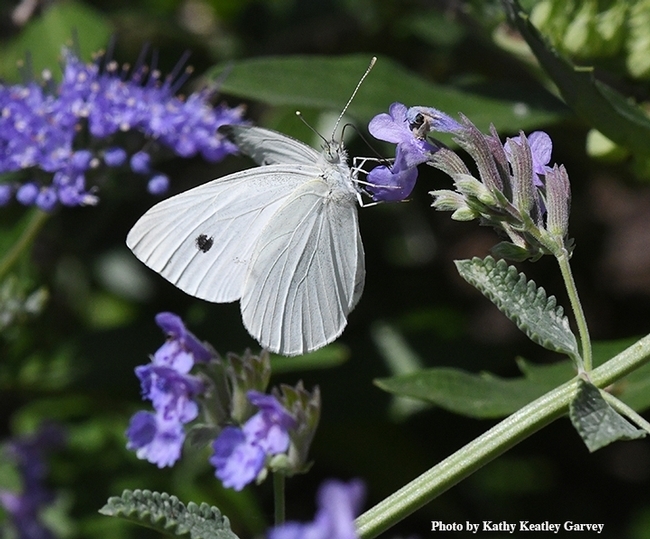
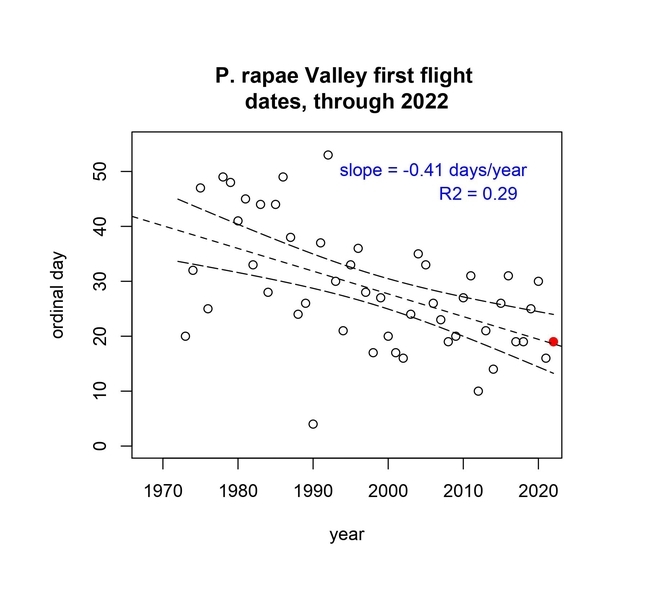
- Author: Kathy Keatley Garvey
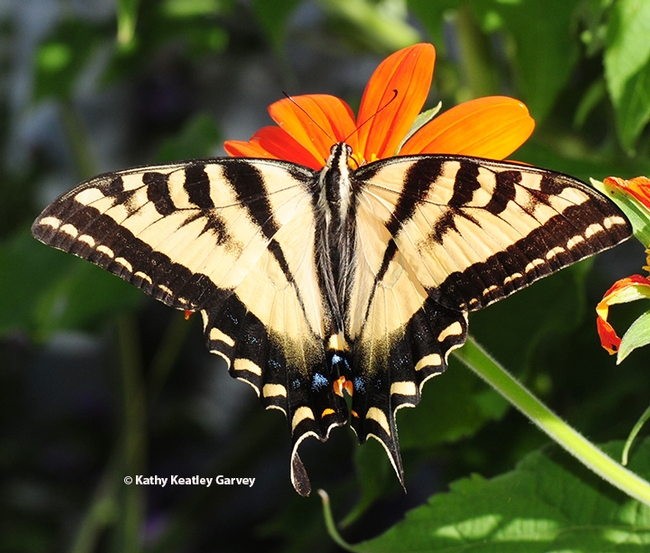
It's not "officially" spring until we see--and photograph--the spectacular Western tiger swallowtail, Papilio rutulus.
One landed March 30 on an aromatic white lilac bush in Alamo Creek Park, Vacaville. It lingered long enough for a few photos and then fluttered away.
Butterfly guru Art Shapiro, UC Davis distinguished professor, Department of Evolution and Ecology, saw his first Papilio rutulus of the year on March 4 in Davis. Butterfly enthusiast and naturalist Greg Kareofelas, an associate of the Bohart Museum of Entomology, UC Davis, saw his first on March 23, also in Davis, "and since then, I've been seeing them regularly."
This butterfly's wings are a brilliant yellow with black stripes. Blue and orange spots accent "the tails" on their hindwings. The one we saw in Vacaville was missing some of its "parts," probably due to a close encounter with a predator, maybe a California scrub jay seeking a quick meal.
Professor Shapiro writes on his website: "The Western Tiger Swallowtail is basically a species of riparian forest, where it glides majestically back and forth along the watercourse. It has expanded into older urban neighborhoods where several of its host genera are grown as shade trees, and behaves as if the street were a watercourse. In the high country and on the Sierran east slope its usual host is Aspen."
"One brood (June-July) at higher elevations; one and a partial second at Washington; 2-3 at lower elevations with a long flight season (late February or March-September or October). An avid puddler. Visits Yerba Santa, California Buckeye, Milkweed, Dogbane, Lilies, Coyotemint, etc., etc. and in gardens frequent at Lilac and Buddleia. Spring individuals are smaller and usually paler than summer. Low-elevation hosts include Sycamore (Platanus), Ash (Fraxinus), Cherry and other stone fruits (Prunus), Willow (Salix), Privet (Ligustrum), Lilac (Syringa) and (in Sacramento County) Sweet Gum (Liquidambar)."
Check out Shapiro's newly renovated website at https://butterfly.ucdavis.edu. The work of webmaster Dave Waetjen, it's a must-see and must-read. A colorful male monarch graces the home page.
Shapiro has monitored butterfly populations across central California for more than 45 years. It's part of his continuing effort to regularly monitor butterfly population trends on a transect across central California. "Ranging from the Sacramento River delta, through the Sacramento Valley and Sierra Nevada mountains, to the high desert of the western Great Basin, fixed routes at ten sites have been surveyed at approximately two-week intervals since as early as 1972. The sites represent the great biological, geological, and climatological diversity of central California."
And one of the species is the spectacular Western tiger swallowtail, which Shapiro monitors at all 10 of his sites.
Hello, spring!
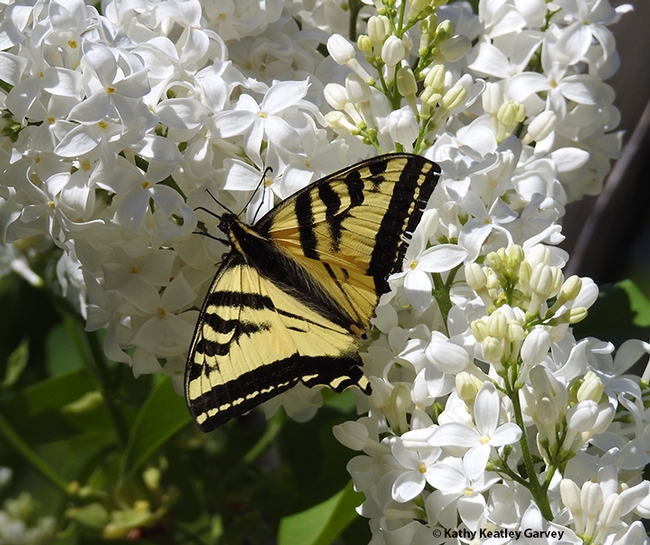
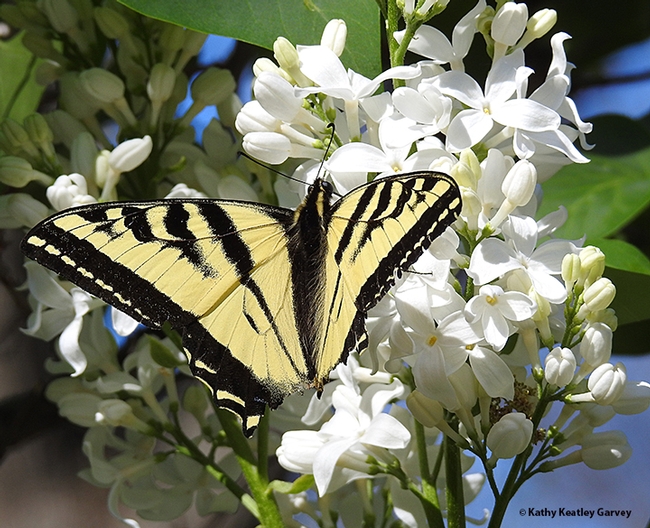
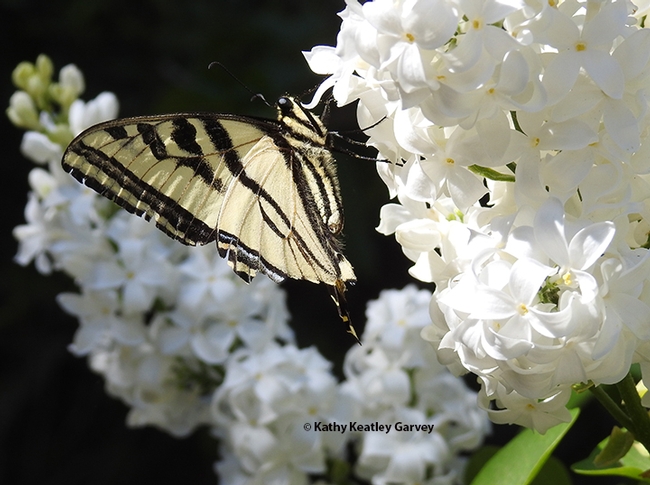
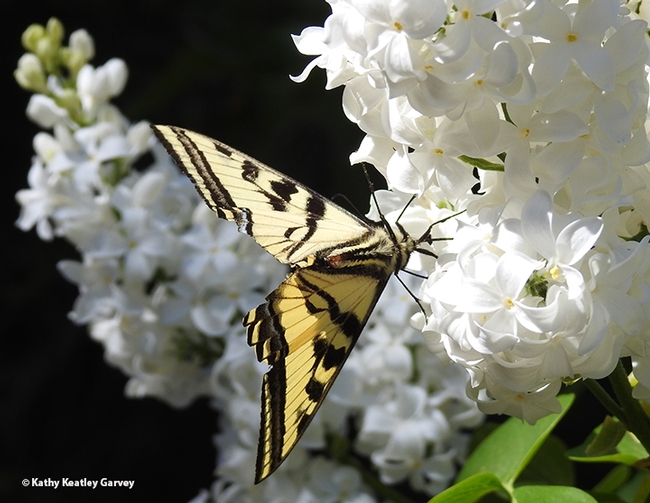
- Author: Kathy Keatley Garvey
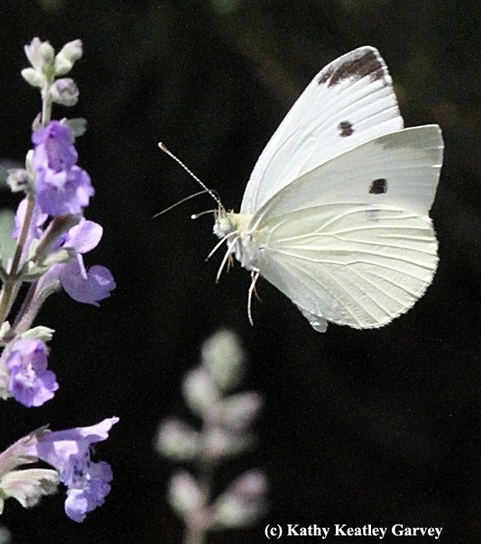
Butterfly guru Art Shapiro, UC Davis distinguished professor of evolution and ecology, knows where they are. As mentioned in a previous Bug Squad blog, he spotted a cabbage white butterfly, Pieris rapae, on Jan. 16 on the UC Davis campus, just south of the Jan Shrem and Maria Manetti Shrem Museum of Art, located at 254 Old Davis Road.
As you probably know, Professor Shapiro always looks for rapae as part of his scientific research; he sponsors the annual Beer-for-a-Butterfly Contest to determine its first flight of the year. COVID-19 canceled this year's contest.
But did you also know that Shapiro found FOUR other butterfly species on his Jan. 16th rounds in Davis, which included Old Davis Road on the UC Davis campus, and residential Davis?
- Red Admiral, Vanessa atalanta, seen in Lot 1 landscaping
- Gulf Fritillary, Agraulis vanillae, spotted in residential Davis, north central
- West Coast Lady, Vanessa annabella, seen on Old Davis Road near the campus hotel.
- Mourning Cloak, Nymphalis antiopa, spotted on Old Davis Road
The links on the species will direct you to his amazing research site, Art's Butterfly World, and the wealth of information.
Our butterfly-spotting record so far: Zero. Zilch. Nada.
But of course, what with the pandemic and all, we haven't been out much. The 100-acre UC Davis Arboretum and Public Garden is a good place to stroll, observe and photograph. We remember spotting a Mourning Cloak in the Arboretum's Ruth Risdon Garden on Saturday, Feb. 6, 2016 on an identification sign for the silver anniversary butterfly bush, Buddleia “Morning Mist."
It was a good place to warm its wings.
Meanwhile, here are a few images of the butterflies that Shapiro saw on Jan. 16. These images were taken in the two-county area of Yolo and Solano.
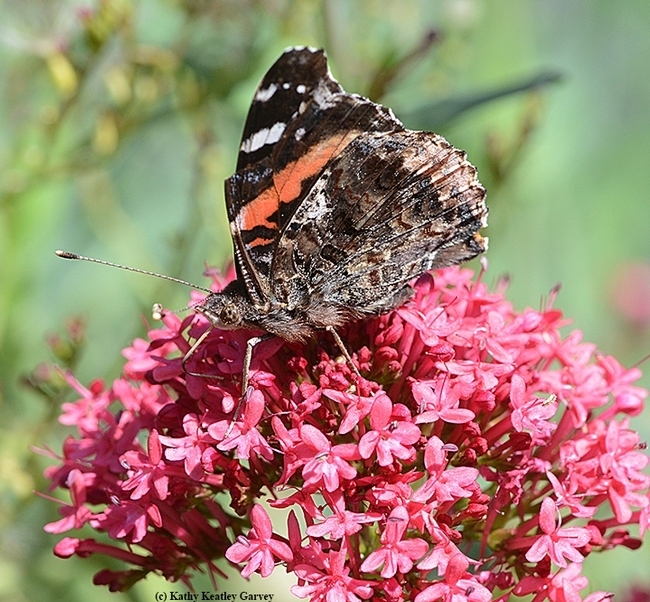
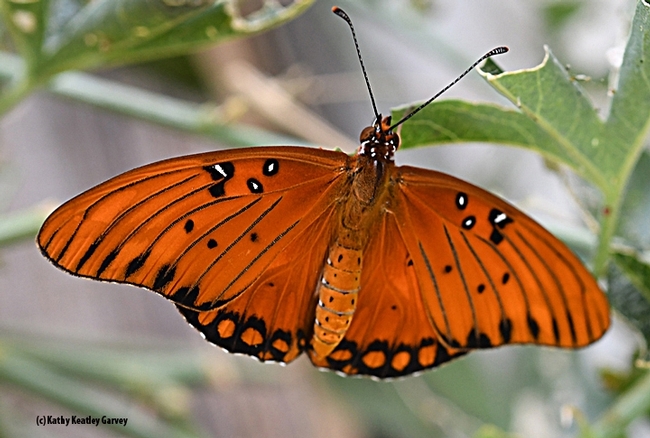
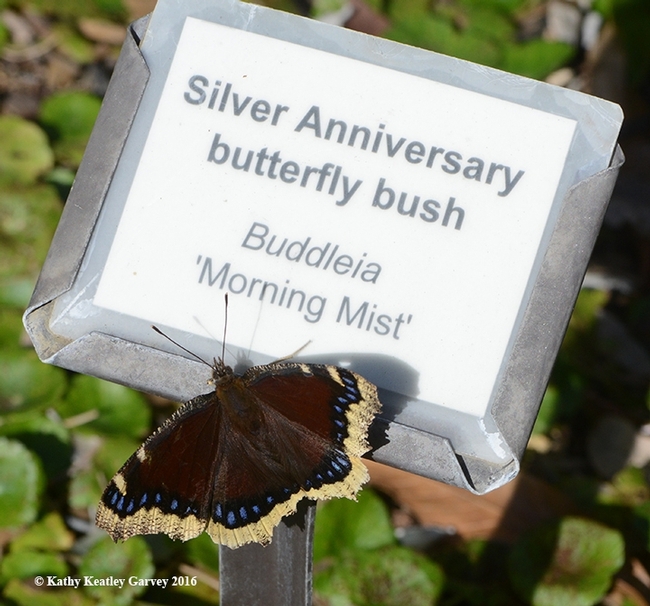
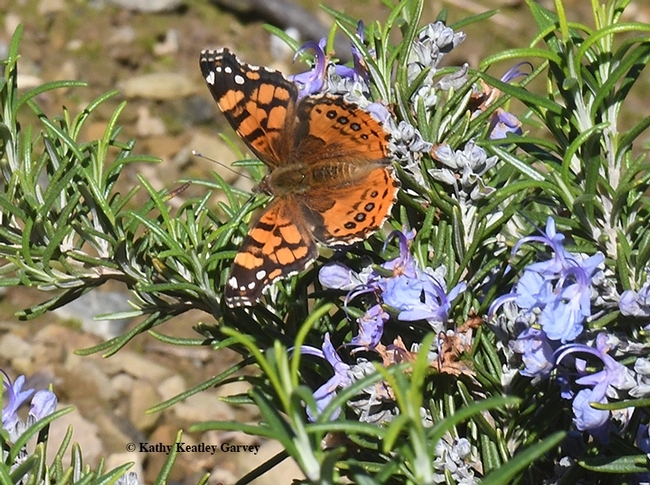
- Author: Kathy Keatley Garvey
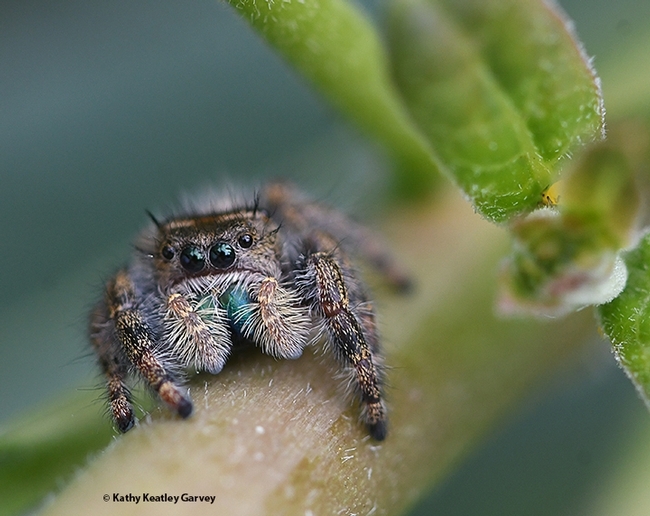
Suds for a bug! What could be better than that?
It's all part of Shapiro's scientific research to determine the bug's first flight of the year. The good professor, who launched the contest in 1972, maintains a research website at http://butterfly.ucdavis.edu/.
It's a little too early to start thinking about cabbage white butterflies, but it wasn't too early for a jumping spider.
For several weeks, we've been admiring a jumping spider hanging out on our Mexican sunflower (Tithonia rotundifolia). Monarchs, Western tiger swallowtails, buckeyes, gray hairstreaks, cabbage whites and assorted other butterflies nectar on it. Our jumping spider (we've named him Herman to distinguish him from the other jumping spiders in our pollinator garden, and besides jumping spiders ought to have a name), nails his share of prey.
So here we are, enjoying a sun spurt on Oct. 30 when a cabbage white butterfly tumbles off the flower as if it were on a bungee cord. A closer look: The butterfly was not alone.
Herman!
Can jumping spiders win the Beer-for-a-Butterfly Contest?
Well, no!
It's not that Herman was just a little bit too early, and the butterfly was just a little bit too slow. Nope.
To claim the prize, you have to deliver the specimen to the UC Davis Department of Evolution and Ecology office at 2320 Storer Hall. Herman neither knows where that is, nor does he care. Plus, the specimen has to be alive, and Herman made sure it wasn't.
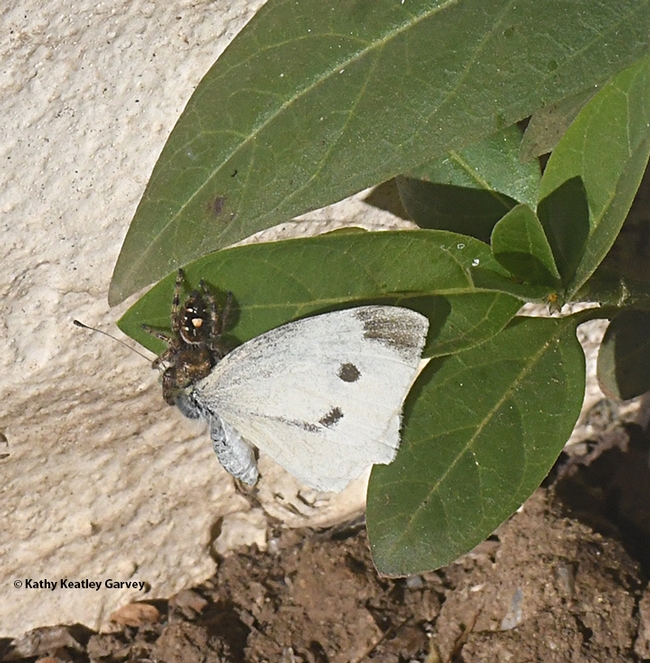
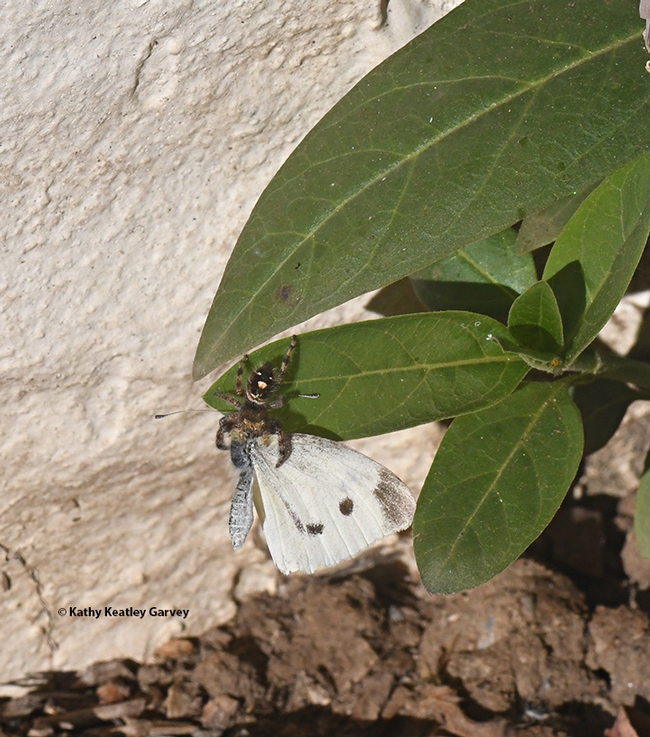
- Author: Kathy Keatley Garvey
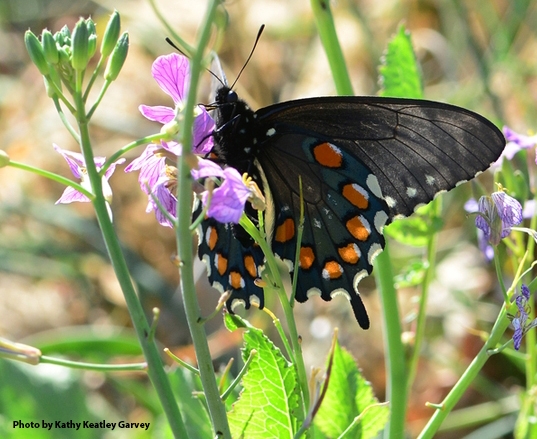
Rising from the Ashes--Some Day
People ask me all the time where butterflies go when it rains. Now they're asking me where they go when it burns.
In a word, to the Elysian fields. They have nowhere else to go!
The unprecedented wildfires have destroyed very important butterfly habitats in 2020, particularly in the High North Coast Range where a million acres – mostly in the Mendocino National Forest – have burned. We have been doing biogeographical survey of the butterfly faunas of this region beginning in 1974. Earlier fires largely removed the fir forest from the upper reaches of Snow Mountain (summit 7056'), leaving it covered in successional montane chaparral. But Goat Mountain (6112'), Hull Mountain (6831'), Anthony Peak (6958'), and Black Butte/Mendocino Pass (7455') still had many intact plant communities containing rare and relict species (many of which were isolated and far-removed from their core ranges in the Sierra Nevada and/or the Klamath Mountains). These included very rare wet meadows (as at Plaskett Meadows near Mendocino Pass) and treeless “balds” on rocky summits, usually facing southwest, producing a simulacrum of alpine fell-fields typically found several thousand feet higher.
We had documented roughly 115 species of butterflies in these places. Some, like the Nevada Arctic (Oeneis nevadensis) and the Arctic Skipper (Carterocephalus palaemon) were at their southernmost range limits, not just in the Coast Range, but globally. One butterfly new to science, the Bald Hills Satyr (Cercyonis incognita), was discovered at mid-elevation on Goat Mountain (100% of which burned) and in a few spots farther north. All of its known habitats may have burned—we won't know until we can get in, not before next year—and it is possible that it is extinct. In addition, we discovered that the widespread, familiar Pine White (Neophasia menapia) was apparently two sibling species on Goat Mountain and near Seven Troughs Spring in the Mendo Pass area, flying several weeks apart and with morphological differences. We did publish that one! All the known localities for the late-season entity have burned, too. This situation is of special interest because the idea that species could originate through temporal isolation has been discussed for many decades, but rarely if ever firmly documented. (The classic case, in field crickets, has been falsified by DNA analysis.) We have to be thankful that we got the data we did before the holocaust. Now, of course, the pressure is on to digest it.
Recovery of the butterfly faunas cannot occur until the vegetation resources they depend on come back—and they may never do so. Glacial relics, like the unique four-petaled Plaskett-Snow Basin race of the bog shooting-star Dodecatheon jeffreyi –personally, I think it deserves species status—may never come back. Nor many of the stranded alpine and edaphic (soil-specialist) species, because they are so far from any conceivable seed source. We have to hope they have persisted in the soil seed bank and may in time recover. Only then can the butterflies re-establish—if there are sources of potential colonizers. The farther any unburned sources and the weaker the dispersal capabilities of the butterflies, the longer the lag times to recolonization. Only the most vagile and broadly-adapted species are likely to recolonize a burned area of a million acres anytime in the next half-century or more.
The fires of 2020 were fed by the combination of 60 percent of recent mean precipitation in the 2019-2020 rainfall year and extraordinary evapotranspiration demand on the vegetation resulting from the hottest late summer on record. Yes, climate change is real. And our Coast Range butterfly faunas may never be the same again.
Resources:
- Sympatric, temporally isolated populations of the pine white butterfly Neophasia menapia, are morphologically and genetically differentiated, PLOS ONE, published May 31, 2007. Authors: Katherine L. Bell, Christopher A. Hamm, Arthur M. Shapiro and Chris C. Nice, https://doi.org/10.1371/journal.pone.0176989
- A New Species of Cercyonis (Lepidoptera: Satyridae) from Northern California, Bulletin of the Allyn Museum, Florida Museum of Natural History, published Sept. 5, 2012. Authors: John F. Emmel, Thomas C. Emmel and Sterling O. Mattoon
Contact: Art Shapiro at amshapiro@ucdavis.edu
